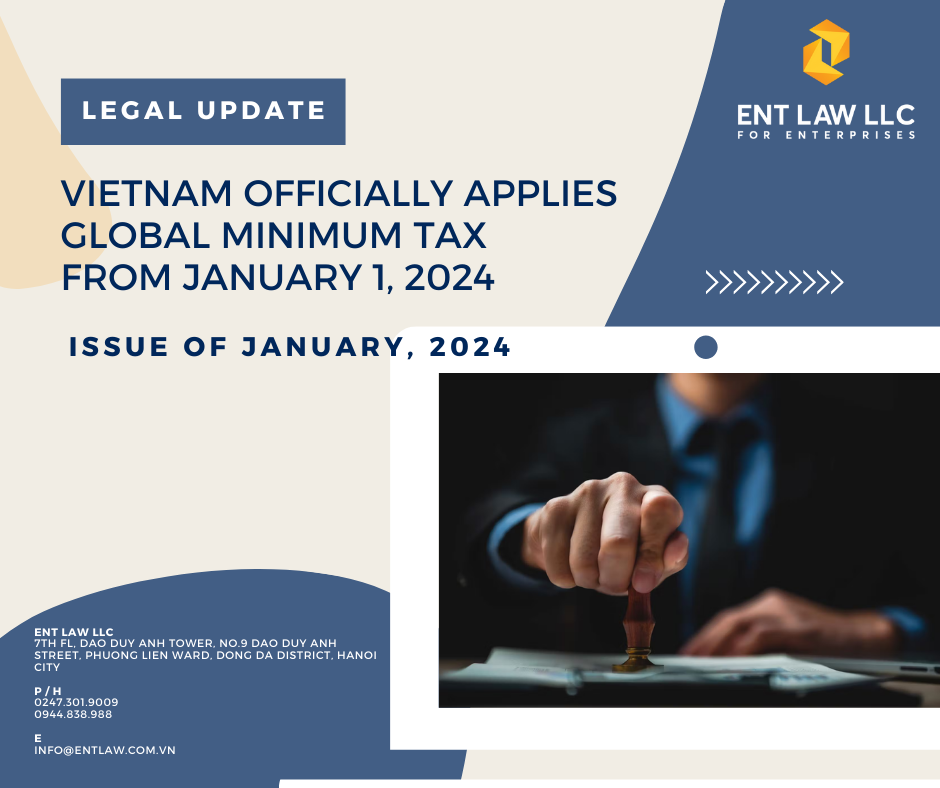 Dear Valued Clients,
Dear Valued Clients,
In recent years, the global minimum tax has been an issue that has received a lot of attention from both the foreign investors and recipient countries community. To implement the global minimum tax regulations, on November 29th, 2023, the National Assembly officially passed Resolution No. 107/2023/QH15 (“Resolution 107”) on the imposition of top-up corporate income tax (“CIT”) under the Global Anti-Base Erosion (GloBE) model rules and applicable from fiscal year 2024.
Therefore, in this Legal Update, we would like to summarize and clarify the policies related to the application of top-up CIT in accordance with GloBE model rules that foreign direct investment (FDI) enterprises in Vietnam need to take into consideration, starting from January 1, 2024.
1. Taxpayers
According to Resolution 107, a taxpayer of top-up CIT under the GloBE model rules is any constituent entity of a Multinational Enterprise (MNE) Group[1] that generates a revenue of at least 750 million euros (EUR) for at least 02 years out of 04 years preceding the fiscal year according to the consolidated financial statement of its ultimate parent entity[2], except for the following cases[3]:
(i) Governmental entities;
(ii) International organizations;
(iii) Non-profit organizations;
(iv) Pension funds;
(v) Any investment fund that is an ultimate parent entity
(vi) Any real estate investment vehicle that is an ultimate parent entity;
(vii) Any entity where at least 85% of its asset value is owned directly or through a chain of excluded entities mentioned in section (i) through section (vi)
2. Qualified Domestic Minimum Top-Up Tax (QDMTT)
Constituent entities or collections of constitution entities of MNE Groups having business operation in Vietnam in the fiscal year shall apply regulations on QDMTT[1].
Where constituent entities or collections of constitution entities have GloBE Income and the Effective Tax Rate in Vietnam is below the minimum tax rate, the QDMTT accrued in Vietnam shall be determined as follows:
- QDMTT shall be determined in accordance with the following formula:
| QDMTT | = ( | Top-up Tax Percentage | x | Excess Profit | ) + | Additional Current Top-up Tax (if any) |
In which:
- Top-up Tax Percentage shall be determined in accordance with the following formula:
| Top-up Tax Percentage | = | Minimum Rate
(15%) |
– | Effective Tax Rate |
- Effective Tax Rate in Vietnam shall be calculated every fiscal year in accordance with the following formula:
| Effective Tax Rate in Vietnam |
= |
Regulated total corporate income tax accrued in Vietnam in the fiscal year of constituent entities in Vietnam |
| Net GloBE Income in Vietnam in the fiscal year[2] |
- Excess Profit shall be determined in accordance with the following formula:
| Excess Profit | = | Net GloBE Income | – | (tangible asset carve-out + payroll carve-out)[3] |
QDMTT in a fiscal year shall be zero (0) if the constituent entity or group of constituent entities satisfies all of the following conditions in the fiscal year[4]:
- The average GloBE Revenue in Vietnam is below 10 million EUR;
- The average GloBE Revenue in Vietnam is below 01 million EUR or is a loss.
Every year, if the conditions specified are fully satisfied, the constituent entity may choose whether to apply the QDMTT of 0.
3. Income Inclusion Rule (IIR)
The ultimate parent entity[5], partially-owned parent entity[6], intermediate parent entity[7] in Vietnam is a constituent entity of MNE Group, directly or indirectly owns an ownership interest in low-taxed constituent entities located in other jurisdictions under the GloBE rules at any time during the fiscal year shall declare and pay a minimum amount of tax equal to its allocable share of Top-up Tax under the GloBE rules of these low-taxed constituent entities for the fiscal year, unless this Top-up Tax has been paid in another jurisdiction that is required to apply a Qualified IIR under the GloBE rules.
Accordingly, jurisdictional Top-up Tax shall be determined in accordance with the following formula:
| Jurisdictional Top-up Tax | = ( | Top-up Tax Percentage | x | Excess Profit | ) + | Additional Current Top-up Tax (if any) | – | Qualified Domestic Minimum Top-up Tax (if any)[8]. |
In which:
- Top-up Tax Percentage, Excess Profit shall be determined similar to the case of QDMTT.
- Jurisdictional Effective Tax Rate shall be calculated every fiscal year in accordance with the following formula:
|
Jurisdictional Effective Tax Rate |
= |
Regulated total corporate income tax accrued in the jurisdiction in the fiscal year of all constituent entities in that jurisdiction |
| Net GloBE Income in the jurisdiction in the fiscal year[9] |
Top-up Tax of a constituent entity in a jurisdiction with GloBE Income in the fiscal year included in the computation of Net GloBE Income of that jurisdiction shall be determine in accordance with the following formula[10]:
| Top-up Tax of a constituent entity | = | Jurisdictional Top-up Tax | x |
GloBE Income of the constituent entity |
| Aggregate Globe Income of all constituent entities in the jurisdiction |
A parent entity’s allocable share of the Top-up Tax of a low-taxed constituent entity equals (=) Top-up Tax of the low-taxed constituent entity multiplied by (x) the parent entity’s Inclusion Ratio for the low-taxed constituent entity in the fiscal year. The parent entity’s Inclusion Ratio for the low-taxed constituent entity shall be determined in accordance with the following formula[11]:
| Parent entity’s Inclusion Ratio for the low-taxed constituent entity in the fiscal year |
= |
GloBE Income of the low-taxed constituent entity for the fiscal year | – | Income attributable to ownership interests held by other owners |
|
GloBE Income of the low-taxed constituent entity for the fiscal year |
||||
Jurisdiction Top-up Tax in a fiscal year shall be zero (0) if the constituent entity or group of constituent entities satisfies all of the following conditions in the fiscal year[12]:
- The average GloBE Revenue of such jurisdiction is less than 10 million EUR;
- The average GloBE Income of such jurisdiction is less than 01 million EUR or is a loss.
Every year, if the conditions specified are fully satisfied, the constituent entity may choose whether to apply the QDMTT of 0.
4. Tax declaration, payment and administration
With regard to regulations on QDMTT, the time limit for submission of declarations of QDMTT, Top-up Tax enclosed with written explanation for differences between financial accounting standards and payment of Top-up Tax is 12 months after the end of the fiscal year[13].
Regarding Income Inclusion Rule (IIR), the time limit for submission of information declarations under the GloBE rules, declarations of Top-up Tax enclosed with written explanation for differences between financial accounting standards and payment of Top-up Tax is 18 months after the end of the first fiscal year in which the MNE Groups become subject to the GloBE rules; 15 months after the end of succeeding fiscal years[14].
ENT Law LLC
The full version of this Legal Update can be found here.
———————————————————————————-
[1] Article 4.1 Resolution 107.
[2] Article 4.7 Resolution 107.
“7.Net GloBE Income in Vietnam in the fiscal year
Net GloBE Income = GloBE Income of all constituent entities – GloBE Loss all constituent entities.”
[3] Article 4.8 Resolution 107.
[4] Article 4.9 Resolution 107.
[5] Article 3.4 Resolution 107.
“An “ultimate parent entity” means an entity of an MNE Group that has the right to control or own directly or indirectly other entities of an MNE Group, is not owned or controlled by any other entity, and whose consolidated financial statement is not consolidated into the financial statement of any other entity globally.”
[6] Article 3.6 Resolution 107.
“A “partially-owned parent entity” means a constituent entity of an MNE Group (other than the ultimate parent entity, permanent establishment or investment entity) that:
- a) owns directly or indirectly an ownership interest in another constituent entity of the same MNE Group; and
- b) has more than 20% of the ownership interests in its profits held directly or indirectly by entities that are not constituent entities of the MNE Group.”
[7] Article 3.5 Resolution 107.
“An “intermediate parent entity” means a constituent entity of an MNE Group (other than the ultimate parent entity, partially owned parent entity, permanent establishment or investment entity) that directly or indirectly owns an ownership interest in another constituent entity in the same MNE Group.”
[8] Article 5.9 Resolution 107
“QDMTT is the amount payable under Regulations on QDMTT in another jurisdiction in the fiscal year”.
[9] Net income under the Global Minimum Tax Regulations in Vietnam is determined in accordance with the provisions of Article 4.7 of Resolution 107.
[10] Article 5.10 Resolution 107.
[11] Article 5.11 Resolution 107.
[12] Article 5.12 Resolution 107.
[13] Article 6.1 Resolution 107.
[14] Article 6.2 Resolution 107

 Tiếng Việt
Tiếng Việt


 Dear Valued Clients,
Dear Valued Clients,
Issue of November 2025 – Decision 36/2025/QĐ-TTg (“Decision 36”) on the issuance of the Vietnam Standard Industrial Classification system
Dear Valued Clients, On September 29, 2025, the Prime Minister promulgated Decision 36/2025/QĐ-TTg (“Decision 36”) on the issuance...
Nov
Issue 201125 – Collective bargaining (principles, issues, representatives, procedures, sectoral collective bargaining, multi‑enterprise collective bargaining, collective bargaining council)
Dear Value Client, In the context of increasingly diverse labor relations in Vietnam, the establishment of dialogue mechanisms...
Nov
Issue of October 2025 – Decree No. 181/2025/NĐ-CP detailing and guiding the implementation of certain articles of the Law on Value-Added Tax
Dear Valued Clients, On July 1, 2025, the Government promulgated Decree No. 181/2025/ND-CP (“Decree 181”), which provides detailed...
Oct
Issue 171025 – Private offering of corporate bonds
Dear Valued Clients, In the context of Vietnam’s growing capital market, the need to diversify mobilized capital sources...
Oct